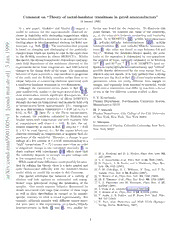
Comment on "Theory of metal-insulator transitions in gated semiconductors" (B. L. Altshuler and D. L. Maslov, Phys. Rev. Lett. 82, 145 (1999)) PDF
Preview Comment on "Theory of metal-insulator transitions in gated semiconductors" (B. L. Altshuler and D. L. Maslov, Phys. Rev. Lett. 82, 145 (1999))
Comment on “Theory of metal-insulator transitions in gated semiconductors” (4January 1999) In a new paper, Altshuler and Maslov [1] suggest a havior was found for the resistivity. To illustrate this model to account for the experimentally observed de- point further, we consider the value of the resistivity, crease in resistivity with decreasing temperature which ρc, at the separatrix between conducting and insulating hasbeenattributedtoatransitiontoanunexpectedcon- phases. In Si MOSFET’s [2,3], p-SiGe heterostructures ducting phase in two-dimensional electron (or hole) sys- [4], p-GaAs/AlGaAs heterostructures [5,6,8], n-AlAs 9 9 tems(see,e.g.,Refs.[2–9]). Themechanismtheypropose heterostructures [7], and n-GaAs/AlGaAs heterostruc- 9 is based on charging and discharging of the positively- tures [9], this value was found to vary between 0.4 and 1 chargedtrapswhichareknowntoexistintheoxideclose 3h/e2. Within the Altshuler-Maslov model, the resis- n to the Si-SiO2 interface in silicon MOSFET’s. Within tivity at the separatrix is determined by two quantities: a thismodel,thestrongtemperaturedependenceandmag- the number of traps, variously estimated to be between J netic field dependence of the resistance observed in the 1010 [10] and 1012cm−2 [11] in Si MOSFET’s (and un- 3 experiments derive from temperature- and field-induced knowninGaAs/AlGaAsheterostructures),and“critical” changes in the charge state of the traps. The anomalous particle density determined by the trap energy level ǫt, ] l behaviorofthese materialsis thus ascribedtoproperties whichis alsonotknown. Itis veryunlikelythatastrong e - of the oxide and the Si-SiO2 interface rather than to in- function(seeEq.9a,binRef.[1])oftwolargelyunknown r trinsic behavior of interacting electrons associated with parameters which are surely different from sample to t s a conductor-insulator transition in two dimensions. sample, and especially from material to material, would . t Although the theoretical curves shown in Ref. [1] ap- yield critical resistivities that differ by less than a factor a m pearqualitativelysimilartothe experimentaldata [2–9], of ten in the five different systems studied to date. close examination reveals significant discrepancies. For - d example, the measured resistivity of silicon MOSFET’s S. V. Kravchenko n stronglydependsontemperatureandmagneticfieldonly Physics Department, Northeastern University, Boston, o 1 Massachusetts 02115 c at temperatures below approximately 3TF, correspond- [ ing to a dimensionless temperature t=0.08 (at ǫF/ǫd = M. P. Sarachik 0.25) in Ref. [1] (here TF is the Fermi temperature). Physics Department, City College of the City University 1 v In contrast, the resistivity calculated by Altshuler and of New York, New York, New York 10031 5 Maslov varies with temperature and with magnetic field D. Simonian 0 at temperatures well above t = 0.08. In fact, the cal- 0 culated resistivity is shown in Ref. [1] only for t > 0.05 Department ofPhysics,Columbia University, New York, 1 (t > 0.1 in most figures), i.e., for the regime where one New York 10027 0 observesessentiallynotemperatureormagnetic fieldde- 9 9 pendence of the resistivity. Moreover, a change in gate / voltage of a few percent at t = 0.25 (corresponding to a t a “high” temperature T =TF) causes more than an order m of magnitude change in the calculated resistivity [1], in - sharp contrast with experiments [2–9] which show that d [1] B. L. Altshuler and D. L. Maslov, Phys. Rev. Lett. 82, the resistivity depends so strongly on gate voltage only n 145 (1999). o at low temperatures, T <<TF. [2] S. V. Kravchenkoet al.,Phys. Rev.B 51, 7038 (1995). c Whilesomeofthesedifferencescouldpossiblybereme- [3] D. Popovic, A. B. Fowler, and S. Washburn, Phys. Rev. v: died by refining the theory, there is a more general and Lett. 79, 1543 (1997). i quite fundamental difficulty with the Altshuler-Maslov [4] P. M. Coleridge, R. L. Williams, Y. Feng, and P. Za- X model which we would like to raise in this Comment. wadzki, Phys.Rev.B 56, R12764 (1997). r The model attributes the behavior of a variety of [5] Y. Hanein et al.,Phys.Rev. Lett.80, 1288 (1998). a electron and hole systems to unintended and uncon- [6] M. Y.Simmons et al.,Phys.Rev.Lett.80, 1292 (1998). trolled traps introduced during the fabrication of the [7] S. J. Papadakis and M. Shayegan, Phys. Rev. B 57, samples. One surely expects behavior determined by R15068 (1998). [8] J. Yoon et al., preprint cond-mat/9807235. details associated with traps (the number of these traps [9] Y. Hanein et al.,Phys.Rev. B 58, R13338 (1998). as well as their distribution in energy) to be sample- [10] T. Ando, A. B. Fowler, and F. Stern, Rev. Mod. Phys. specific, contrary to what is found experimentally. For 54, 437 (1982). example, although samples with different spacer mate- [11] T. Hori, Gate Dielectrics and MOS ULSIs (Springer- rial were used in the experiments on p-GaAs/AlGaAs Verlag, Berlin, Heidelberg, 1997). heterostructures in Refs. [5] and [8], very similar be- 1
